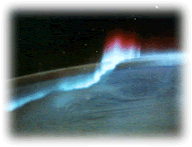Common menu bar links
Natural Elements
On-Line Newsletter
 Aurora Borealis from space.
Aurora Borealis from space.Natural Resources Canada has a lot on the go this year, and this variety is reflected in the latest edition of Natural Elements.
This month, you’re invited to visit the Turkey Lakes Watershed, which has been a model for research collaboration. You’ll learn how NRCan's clean energy software is becoming the de facto world standard. You’ll also read about how NRCan is helping NASA and the University of Calgary unravel the mystery of the aurora borealis.
And finally, as part of our ongoing updates on International Polar Year projects, you’ll meet NRCan glaciologist David Fisher and his colleagues, who’ll be studying Greenland’s ice cores to determine the earth’s climatic conditions 130,000 years ago.
Issue 13, April


Turkey Lakes Watershed - Forest Soils Research in a Large-Scale Environmental Laboratory
Since its inception, the Turkey Lakes Watershed has been a model for research collaboration. Read on

RETScreen Software Passes 100 000 User Milestone
The world-leading RETScreen software package recently passed the 100 000 user milestone. Demand for the software, which helps decision-makers plan for projects that use renewable energy and co-generation technologies, is still growing rapidly. Read on

The Fascinating Mysteries of the Aurora Borealis
Galileo Galilei named them aurora borealis, Latin for “dawn of the North.” The University of Calgary and NRCan’s Geomagnetic Laboratory are working with NASA to unravel their mystery. Read on

Drilling Into the Past
The Greenland ice sheet contains some of the oldest untouched ice in the world: it is more than 131,000 years old. With an ice core from the Greenland ice sheet, David Fisher will have a once-in-a-lifetime opportunity to study more than 100,000 years of climate history. Read on





